Abstract
Alangium lamarkii is a member of the family Alangiaceae. Traditional medicine has employed Alangium salvifolium to treat a variety of illnesses. In the Ayurvedic and Siddha medical traditions, nearly every component of A. salvifolium including the roots, leaves, stem, and bark is used to cure a variety of illnesses. The biologically active components of A. lamarkii encompass various compounds, classified as flavonoids, glycosides, alkaloids, saponins, carbohydrates, triterpenoids, tannins, and steroids, and thin layer chromatographic studies have been performed on the various extracts to establish quality standards for this botanical medicine. The present review highlights phytoconstituents present in Alangium lamarkii Studies have come out with the structural elucidation of several compounds belonging to alkaloids, terpenoids, and other groups. Also evidence-based studies on various pharmacological effects of the plant.
Keywords
Alangium salviifolium, Alangiaceae, Pharmacological Activities, Phytoconstituents, Anti-depressant, Herbal.
Introduction
One of the most significant sources of medication is plants. In poor nations, traditional medicine has been a significant part of the healthcare system. The affordability of traditional medicine is the reason for its demand. The WHO estimates that more than 80% of the world's population receives primary healthcare through traditional medicine, the majority of which is plant-based. The usage of medicinal plants has evolved over the ages into a significant aspect of daily life as a result of advancements in pharmaceutical and medical science. In India, some 3000 plant species are thought to have therapeutic qualities. An estimated 40% of people on the planet rely only on plant-based medication for their medical needs. [1] Plants have the ability to synthesize a wide range of chemical compounds that are used to perform biological compounds. The therapeutic potential of plants is due to the presence of metabolites present in the plant such as alkaloids, phenolic, flavonoids, phenol, and tannin. Ankol (Alangium lamarkii) synonym Alangium salviifolium (Linn. f.) wang. It belongs to the family Alangiaceae and is commonly known as sage-leaved alangium. The genus Alangium consists of 22 species that are growing throughout India. All parts of plants such as stems, leaves, roots, and bark, are being used to make medicines that are used to cure illnesses. Ankol oil is used in Ayurvedic medicine. Ankol seed is used to improve stamina and physical performance. While Ankol oil is also valuable in itching, herpes, and other skin disease. This tree grows up to 20 m in height, clusters of 4 to 8 flowers, at times only a single flower, which is dense and fragrant, cream color. Ankol oil is also valued for healing snakebites, scorpion bites as well as a dog bites. Alangium salviifolium is the most useful medicinal plant having a wide spectrum of biological activity. It has the potential for anti-diabetic, anticancer, diuretic, anti-inflammatory, antimicrobial, laxative, anthelmintic, and antiepileptic activities. The plant was also reported for its antifungal activity, antimicrobial activity, cardiac activity, and antifertility activity. [2]
GEOGRAPHICAL DISTRIBUTION OF ALANGIUM LAMARKII:
Alangium lamarkii is distributed in many countries like Thailand, the Philippines, and Indonesia. It is also found in Africa, Southern and Eastern Asia, and tropical Australia. In India, it is found in different states of India like Tamil Nadu, Andhra Pradesh, Bihar, Gujarat, Kerala, Karnataka, Chhattisgarh, Himachal Pradesh, Maharashtra, Odisha, Rajasthan, Uttar Pradesh, and West Bengal. [3]
BOTANICAL DESCRIPTION:
Sage-leaved alangium tall, prickly sage-leaved alangium tree is indigenous to India. It can reach a height of three to ten meters. The bark has a rough, mild ash color. The ankol tree has smooth bark at first, but as it ages, cracks in the bark cause the tree to appear youthful and rough. The bark is colored from pale brown to yellow. There are many uses for the wood, including musical instruments and decorations. The 7.6–15.2 cm long, elliptic-oblong leaves have a wedge-shaped base, an entire margin, a blunt tip, and a papery to nearly leathery texture before going bald. Bisexual blooms are borne in stalkless clusters of four to eight blossoms. [4] Stalks of flowers are 2–8 mm. The fragrant, cream-colored flowers measure 1.2–3 cm. Four to ten petals, basally enlarged at tip blunt, 1.2–3 cm; filaments 4–12 mm; stamens 10–30; at tip geniculate and bearded; style hairless, 8–24 mm; outside woolly, inside less so. Berries are smooth, hairless, ellipsoid, nearly spherical, violet to purple, and measure 9–24 x 6–16 mm. blooms from February to June. When ripe, the tiny, almost spherical fruits have a purple-red colour and are topped by a prolonged calyx limb. Blooming from March to May. Drupe fruit bearing one or two seeded berries. The juicy pulp of the apple tastes sweet and has a nice aroma. [5
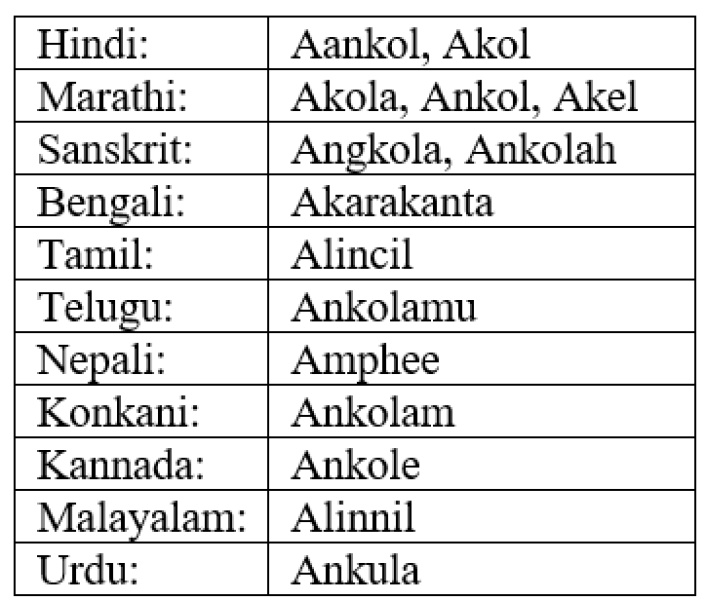
Table 1: Taxonomical classification: [4]

Table 2 : Vernacular Name:[4]
PRELIMINARY PHYTOCHEMICAL INVESTIGATION:
The different successive extracts obtained from Alangium salviifolium (Linn. f.) wang were subjected to preliminary phytochemical screening by applying different qualitative tests for phytoconstituents. The different extracts contained Saponins, alkaloids, carbohydrates, phenolic compounds, steroids, flavonoids, proteins, amino acids, and volatile oil. The presence of these phytoconstituents was confirmed by TLC. [6]
Alkaloids:-
- Dragendorff’s Test –
Take 1ml of the solvent extract, add an equal volume of distilled water, and add 1ml of Dragendorff’s reagent. The orange or red color is formed, indicating the presence of alkaloids.
- Mayers Test –
Take 1ml of solvent extract, and add 1ml of Mayers reagent. A white or pale yellow precipitate is formed, indicating the presence of alkaloids.
Flavonoids:-
- Ferric chloride Test –
Take the solution of the extract, and add a few drops of neutral ferric chloride solution. The formation of a blackish-red color indicates the presence of flavonoids.
- Shinod’s Test –
Take 1ml of solvent extract diluted with 3ml of ethanol and a pinch of Mg in a test tube, shaken gently. Pink or brown precipitate indicated the presence of flavonoids.
Carbohydrates:-
- Molischs Test –
Take 1ml of solvent extract and add 10ml of water in a test tube, shaken and filtered. In filtrated, add 1ml of Molisch reagent was added followed by a few drops of Conc. Sulphuric acid from the side of the test tube.Brown purple ring at the junction of liquid, which indicates the presence of carbohydrates
- Fehling Test –
Take 1ml of solvent extract and add 10ml of water in a test tube, shake & filter. In filtrate 1ml of Fehling solution A and 1ml of Fehling solution B and keep in a boiling water bath for 5-10 min. Brick re-precipitate confirms the presence of sugars.
Saponins:-
- Foam Test –
Take 5ml of solvent extracts in test tubes add a drop of sodium bicarbonate, shake. formation of a cloudy white precipitate indicated the presence of saponins.
Triterpenoids:-
- Salkowaski Test –
Take 1ml of solvent extract in a test tube and add conc. Sulphuric acid and shake an allowed to stand, lower layer turns yellow.
Tannins:-
- Gelatin Test –
Take 1ml of solvent extract and add 1% solution of gelatin containing 10% sodium chloride formation of a white precipitate indicates the presence of tannin.
Steroids:-
- Take 1 ml of the extract was dissolved in 10 ml of the chloroform and equal volume of sulphuric acid was added to a test tube. If the upper layer turns red and sulphuric acid layer shows yellow with green fluorescence. This indicates the presence of steroids.
Glycoside:-
- Take 1ml of conc. sulphuric acid gently poured on the walls of an incline test tube containing 1ml of extract. Dropwise was added 10?rric chloride solution and observed for a brown, violet, or greenish ring.[7]
PRINCIPLE OF TLC:
Thin layer chromatography, or TLC, is a chromatography technique this method used for analyzing mixtures by separating the compounds in the mixture. TLC is used to determine the compounds present in a given substance, the number of compounds, purity of a compound. Thin layer chromatography is performed on a glass, aluminum foil, and plastic sheet. Which is coated with usually silica gel, aluminum oxide, or cellulose as the solid phase. The thin layer of absorbent is known as the stationary phase. The principle of thin-layer chromatography is the distribution of a compound between a solid phase applied to any plate and a liquid mobile phase (solvent) that is moving over the solid phase. A starting point just above the bottom of the TLC plate is applied by a small amount of compound. [8]
Step 1:
Prepare the developing container
The developing container for TLC can be a specially designed chamber, a jar, or a beaker with a watch glass on the top. Pour solvent into the chamber to a depth of just less than 0.5 cm. To aid in the saturation of the TLC chamber with solvent vapors, you can line part of the inside of the beaker with filter paper. Cover the beaker with a watch glass, and allow it to stand while you prepare your TLC plate.
Step 2:
Prepare the TLC Plate
These are used for applying the thin layer of the stationary phase. They are inert or stable. The layer of stationary phase is kept even throughout these plates for better analysis. Usually, ready-to-use plates are preferred for conducting experiments.
Step 3:
Develop the plate
Place the TLC plate in the developing chamber, and cover the beaker with the watch glass, the solvent will raise the TLC plate by capillary action. Allow the plate to develop until the solvent is about half Remove the plate from the beaker and immediately mark the solvent front with a pencil. Allow the plate to dry.
Step 4:
Visualize the spots
If there are any colored spots, circle them lightly with a pencil. Most samples are not colored and need to be visualized with a UV lamp.
Rƒ values: Rƒ = Distance of center of spot from starting point / Distance of solvent from starting point [9]
PHYTOCHEMICAL CONSTITUENTS:
Phytochemical screening of the plant Alangium salviifolium (Linn. f.) wang extracts was done by applying some previously established methods. The majority of the extract contained flavonoids, alkaloids, tannins, steroids, triterpenoids, and glycosides.
Leaves Extract:-
The alcoholic and aqueous extract of Alangium lamarkii contains Alkaloids, carbohydrates, tannins, amino acids, phenols, triterpenoids, and Phytosterols. The total ash of the leaf was found to be 7.62% w/w, acid insoluble ash was 1.66% w/w and water soluble ash was 2.11% w/w. Also according to certain research, the Methanol extract of leaves contains steroids and glycosides. [2]

Table 3: TLC of the leaves of various extracts of the Alangium lamarkii.[10]
Seed Extract:-
Phytochemical screening of the water extract of ankol seed shows the presence of carbohydrates and glycosides. While Petroleum ether showed the presence of steroids and glycosides, protein. A. landmarks have also found Algimarine, Algimaridine, Alamanine, Betulinic acid, Betuline, Betulinaldehyde, Emetine, Cephaeline, N-methyl cephaeline, Psychotrine, and Lipeol.[11]

Table 4: TLC of the seed of various extracts of the Alangium lamarkii [12]
Fruit Extract:-
Fruit Extract:-
The water extract of A.lamarkii shows the presence of Alangiside, deoxytobulosine, and N-methyl cephaeline.[11]

Table 5: TLC of the fruit of various extracts of the Alangium lamarkii [13]
Roots Extract:-
According, to certain research, the ethanol Extract of A. lamarkii root shows the presence of alkaloids, glycoside, flavonoids, terpenoids, phytosterols, tannins, saponins, triterpenes. Ankol roots also contain Alangium A & B, Alangine, Alangiside, Cephaeline, Emetine, Isotubulosine, Marckidine, Marckine, Psychotrine, and Tubulosine. [11]
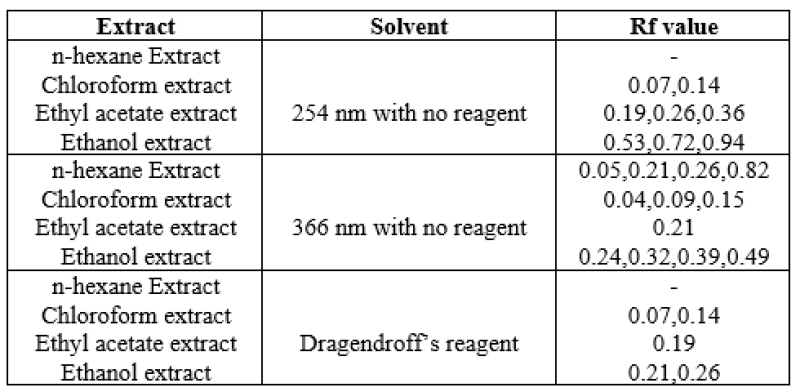
Table 6: TLC of the root of various extracts of the Alangium lamarkii [14]
Flower extract:-
The phytochemical screening of methanol and chloroform extract of A. lamarkii shows the presence of alkaloids, flavonoids, tannins, phenol, steroids, phytosterol, and carbohydrates.[1

Fig 1 Aangium Lamarkii Leaves

Fig 2 Bark
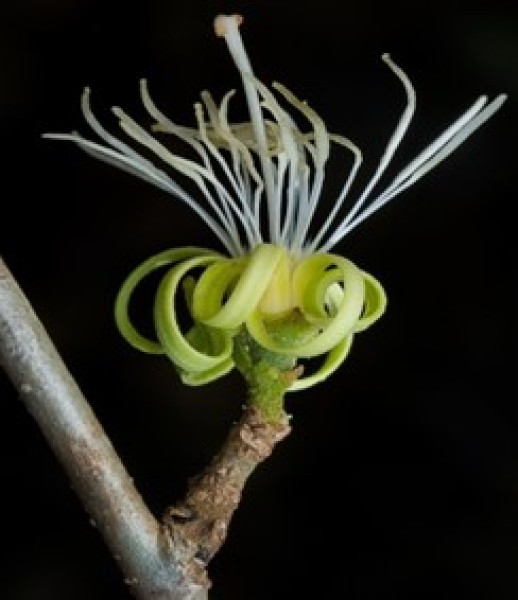
Fig 3 Flower
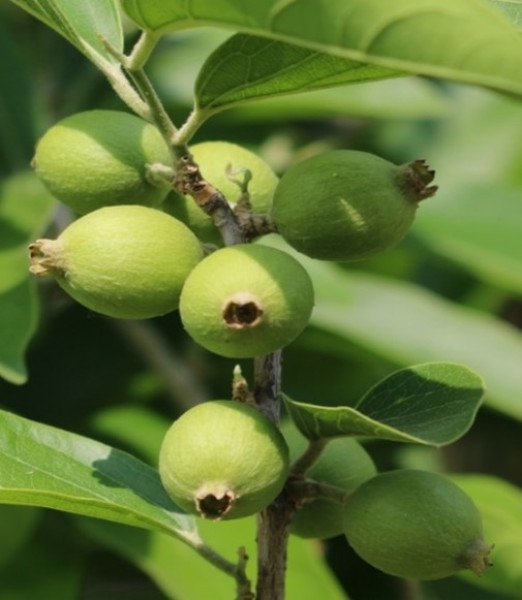
Fig 4 Fruits
TRADITIONAL USES:
Sage-leaved alangium is well known for its medicinal uses in many traditional medicinal systems in the treatment of skin cancers by local application of the root. It also reduces blood pressure due to its vasodilation property, blood disorders, diarrhea, purgative, and cure piles. The ankol leaf paste is used in treating pain linked to rheumatic and Osteoarthritis and also treated asthma. Fruit juice can be locally applied for eye-related disorders, expectorant, and as an antidote for poisoning. Seed is used to treat digestive problems and intestinal colics, and cure bronchial asthma. The bark is used as an emetic. A. lamarkiii has many traditional uses pungent, alleviates spasms, and antiprotozoal, it used in the treatment of malaria. [16]
PHYTOCONSTITUENTS PRESENT IN ALANGIUM LAMARKII:
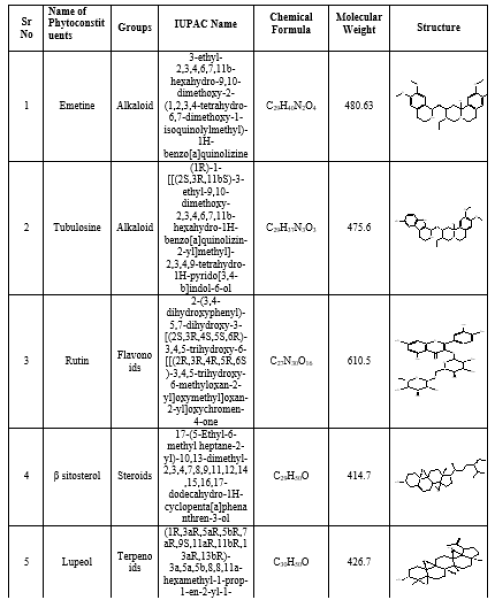
Table 7: Phytoconstituents present and its structure in Alangium lamarkii [17]
IN-VIVO PHARMACOLOGICAL ACTIVITIES:
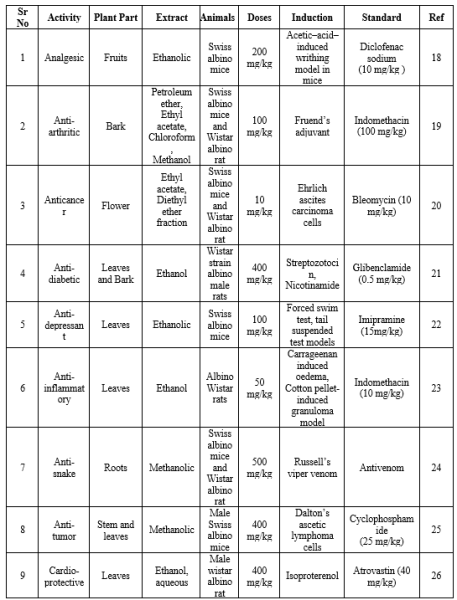
Table 8: In-vivo Pharmacological Activities of Alangium lamarkii
IN-VITRO PHARMACOLOGICAL ACTIVITY:
- Cytotoxic
The study investigates Alangium salvifolium seeds Ethanol and Ethyl acetate extracts having cytotoxic activity against human skin melanoma (A375) and human skin carcinoma (A431) cell lines in vitro. Phytochemicals study of ethanol and ethyl acetate extract using standard method show the presence of Flavonoids, Triterpenoids, steroids, Protein, and amino acids, Tanin, and Phenolic. In vitro, cytotoxicity studies were performed using the MTT assay. The study observations show that EA and EtOH in the A131 cell line show the potential properties with the IC50 concentration at 60.84ug/ml and 47.43ug/ml. The Ethanol and Ethyl acetate extracts show the potential properties with the IC50 concentration at 90.11ug/ml and 50.71ug/ml in the A375 cell line. The study results indicate the ethanol and Ethyl acetate extract showed anticancer activity by significantly inhibiting the percent cell viability and exhibiting considerable cell inhibition.[32]
- Anti-fungal
Chloroform, Petroleum ether, Methanol, and Acetone are various extracts of A.lamarkii seeds. The extracts were tested against the pathogenic fungi, Aspergillus flavus, Fusarium oxysporum, Cladosporium fulvum, and Mucor racemosus. The fungi Aspergillum flavus showed the largest zone of inhibition in methanol extract, whereas Cladosporium fulvum showed the lowest inhibition zone in petroleum ether. The remaining test pathogens showed a modest level of activity in MIC. The minimum inhibitory concentration (MIC) of highly active antifungal medicines is low, whereas the MIC value of low-activity antifungal drugs is large. [33]
3. Anti-bacterial
A. lamarkii flower methanol extract shows antibacterial activity against gram-negative and gram-positive bacteria. Antibacterial activity by disc (100 mg/disc) diffusion method. The methanol extract of Alangium lamarkii flowers, containing steroids and flavonoids, showed good antibacterial activity against both gram-positive and gram-negative bacteria. [34]
CONCLUSION
A. salvifolium is a highly beneficial plant that contains a variety of bioactive compounds. The Ayurvedic, Siddha, and other traditional medical systems have employed almost every aspect of this plant to treat a wide range of illnesses. Plant extracts have been suggested to be potentially effective against cancer, diabetes, epilepsy, hypertension, inflammation, ulcers, and other conditions in contemporary scientific publications. It has been discovered that certain plant portions have biological action, particularly concerning treating metabolic diseases. The medicinal significance of plant parts such leaves, flowers, roots, bark, stems, and stems bark is demonstrated in this review. A unique entity for research and development will result from an additional focus on creating modern formulations after a thorough examination of their bioactivity, pharmacokinetics and pharmacodynamics, safety, etc. utilizing suitable animal models and clinical studies for the treatment of various diseases from A. salvifolium.
REFERENCE
- Pant, M. (2021). Alangium salvifolium Linn: A Threatened Medicinal Plant of India. Mandsaur District, Madhya Pradesh: [International Journal of Medical Studies].
- Ravirala V, Raju AB, Yerragunta VG. Phytochemistry and pharmacology of Alangium salvifolium: a review. Journal of Pharmacy Research. 2011;4(5):1423-5.
- Shravya S, Vinod BN, Sunil C. Pharmacological and phytochemical studies of Alangium salvifolium Wang.–A review. Bulletin of Faculty of Pharmacy, Cairo University. 2017 Dec 1; 55 (2):217-22.
- Ratra M, Gupta R. Comprehensive review on pharmacological profile of Alangium salvifolium: a medicinal plant. Pharmaceutical and Biosciences Journal. 2015 Jun 6:22-8.
- Panara K, Singh PK, Rawat P, Kumar V, Maruf M, Patel K, Ravikumar RK, Kumar V. Importance of Alangium salviifolium and its pharmacological update. European Journal of Medicinal Plants. 2016 Jan 10; 12 (4):1-5.
- Nasrullah M, Haque A, Yasmin Z, Uddin MA, Biswas K, Islam MS. Phytochemical screening, antioxidant and anticholinesterase effects of Alangium salvifolium (LF) Wang root extracts. Journal of Medicinal Plants Research. 2015;9 (42):1060-9.
- Tadesse S, Ganesan K, Nair SK, Letha N, Gani SB. Preliminary phytochemical screening of different solvent extracts of leaves and stems of Commelina benghalensis L.(Family: Commelinaceae). Int. J. Pharm. Chem. Biol. Sci. 2016 Jan 1;6: 103-7.
- Kumar S, Jyotirmayee K, Sarangi M. Thin layer chromatography: a tool of biotechnology for isolation of bioactive compounds from medicinal plants. International Journal of Pharmaceutical Sciences Review and Research. 2013 Jan; 18(1):126-32.
- Bele AA, Khale A. An overview on thin layer chromatography. International Journal of Pharmaceutical Sciences and Research. 2011 Feb 1;2 (2):256.
- Kumar R, Hemalatha S. Pharmacognostical standardization of leaves of Alangium lamarckii Thwaites. Pharmacognosy Journal. 2011 Jan 1;2(18):19-25.
- Yadav A, Garg S, Gupta R, Gangwar N, Sonwalkar PM, Nayak V, Handa AK, Alam B, Arunchalam A. Importance and Uses of Ankol (Alangium Salvifolium). ICAR-Central Agroforestry Research Institute, Jhansi, U.P
- Sharma P. Preliminary phytochemical screening of Ankola seed. Pharma. Innovation J. 2018;7(6).
- Mondal Rp, Ghosh A, Burman S, Chandra G. Efficacy of ethyl acetate extract of Alangium salviifolium fruit pericarp against Culex quinquefasciatus larvae. Notulae Scientia Biologicae. 2022 Jun 14;14(2):11251-.
- Saraswathy A, Meena AK, Shakila R, Kumar KS, Ariyanathan S. Pharmacognostic studies on Alangium salvifolium (Linn. f.) Wang. root bark. Pharmacognosy Journal. 2010 Aug 1;2(11):374-80.
- Nahar L, Zahan R, Mosaddik A, Islam S, Haque A, Fazal A, Jesmin M. Antioxidant and antitumor activity of chloroform extract of Alangium salvifolium flowers. Phytopharmacology. 2012;2 (1):123-34.
- Shankar Ak. Free Radical Scavanging Activity In Cyc Using Alan. Rjps ; 2020:4-6.
- Kantamreddi VS. Evaluation of Indian medicinal plants used traditionally for the treatment of Malaria. Phytochemical investigation of Alangium lamarkii and Tarenna zeylanica for antiplasmodial and cytotoxic properties (Doctoral dissertation, University of Bradford)
- Mosaddik A. Free Radical Scavenging Power Potentiates Analgesic, Anti-Inflammatory And Cns Depressant Activity Of Alangium Salviifolium Wang.
- Jubie S, Jawahar N, Koshy R, Gowramma B, Murugan V, Suresh B. Anti–arthritic activity of bark extracts of Alangium salviifolium Wang. Rasayan J. Chem. 2008;1(3):433-6.
- Zahan R, Alam MB, Islam S, S Chowdhury N, B Hosain S, Mosaddik A, Jesmin M, Haq ME. Anticancer activity of Alangium salvifolium flower in Ehrlich Ascites carcinoma bearing mice.
- Ratra M, Gupta R. Evaluation of antidiabetic activity of ethanol extracts of leaves and barks of Alangium salvifolium in streptozotocin-induced diabetic rats. Pharmaceutical and Biosciences Journal. 2015 Jun 3:15-21.
- Sibgatullah M. Evaluation of Antidepressant Activity of Ethanolic Extract of Alangium Salviifolium (LF) Wangerin in Swiss Albino Mice. Biomedical and Pharmacology Journal. 2017 Mar 25;10(1):427-33.
- Prajapati SK, Manigauha A, Dubey B. Anti-inflammatory and Anti-arthritis Activity of Active Constituents Present in Alangium Salvifolium Leaves Extract. Indian Journal of Research in Pharmacy and Biotechnology (IJRPB). 2019 Mar;7(2):5-17.
- Dharmistha M, Ravi M, Ashvin D. In vitro in vivo Alangium salvifolium and neutralizing potential of extract against Russell's viper (Daboia russelli). Asian Journal of Pharmacy and Pharmacology. 2019;5(5):972-8.
- Venkateshwarlu R, Gopal YV, Raju AB, Prasad KB. Antitumor activity of Alangium salvifolium against Dalton’s ascitic Lymphoma. Medicinal Chemistry & Drug Discovery. 2012;3(2):122-33.
- Gowtham, P., & Dr. Nithya Devi, M. (2019). The Cardio-Protective Potential of Alangium salvifolium.L (Wang): Modulating Lipid Profile and Histological Alterations in Isoproterenol-Induced Myocardial Infarction in Rats. Indian Journal of Applied Research, 9(12).
- Mohanty P, Panda S, Mishra S, Panda P, Jaliwala Y, Milind P. Study of antiulcer activity of roots of Alangium salvifolium Linn. in pylorus ligated rats. Int Res J Pharm. 2011;2:190-2.
- Nangare N.B., Deshpande M.M., Arulmozhi S., & Kurulkar M.A. (2022). "Comparative Study of the Antiurolithiatic Activity of Leea macrophylla, Alangium lamarkii, Saccharum officinarum, Marsdenia tenacissima, Chonemorpha macrophylla, Maerua oblongifolia." International Journal of Current Research and Review.
- Dhruve P, Nauman M, Kale RK, Singh RP. Novel hepatoprotective activity of Alangium salviifolium in mouse model. Drug and Chemical Toxicology. 2022 Mar 4;45(2):576-88.
- Zahan R, Mosaddik MA, Barman RK, Wahed MI, Haque ME. Antibacterial and antidiarrhoeal activity of Alangium salviifolium Wang flowers. Mol. Clin. Pharmacol. 2012;2(1):34-43.
- Jasvir Kaur, Rajmeet Singh, Jaswinder Kaur, Harpreet Kaur, & Jaspreet Kaur. (2020). "Anxiolytic and Motor Coordination Activity of Alangium salvifolium Linn. Seeds in Rats." International Journal of Pharmaceutical Research and Innovation, Volume 13, pp. 1-10.
- Tiwari R, Sharma T, Khatrawi EM, Totewad ND, Gawai DU. ISSN 2063-5346 in vitro cytotoxic potential of medicinal plant alangium salvifolium against cancer cell lines.
- Prathyusha P, Subramanian MS. Antifungal Activity of Seeds of Alangium Salvifolium (LF) Wangerin (Alangiaceae). Biosciences Biotechnology Research Asia. 2016 May 7;8(2):865-8.
Mosaddik MA, Kabir KE, Parvez H. Antibacterial activity of Alangium salviifolium flowers. Fitoterapia. 2000;71(4):447-9


 Sakshi N. Nagre* 1
Sakshi N. Nagre* 1
 Pooja P. Hulke 2
Pooja P. Hulke 2
 Ankit S. Kediya 1
Ankit S. Kediya 1












 10.5281/zenodo.10854559
10.5281/zenodo.10854559